Key takeaways:
- Test coverage is essential in software development, encompassing different types such as statement, branch, and function coverage, each providing unique insights.
- Quality of tests is as important as coverage percentage; meaningful tests in real-world scenarios are crucial for identifying bugs and vulnerabilities.
- Utilizing tools like Jacoco, Istanbul, and Coverage.py can help highlight untested code areas and improve overall test effectiveness.
- Collaborative methods, such as peer code reviews and analyzing coverage results with the team, can uncover overlooked aspects of testing and enhance coverage strategies.
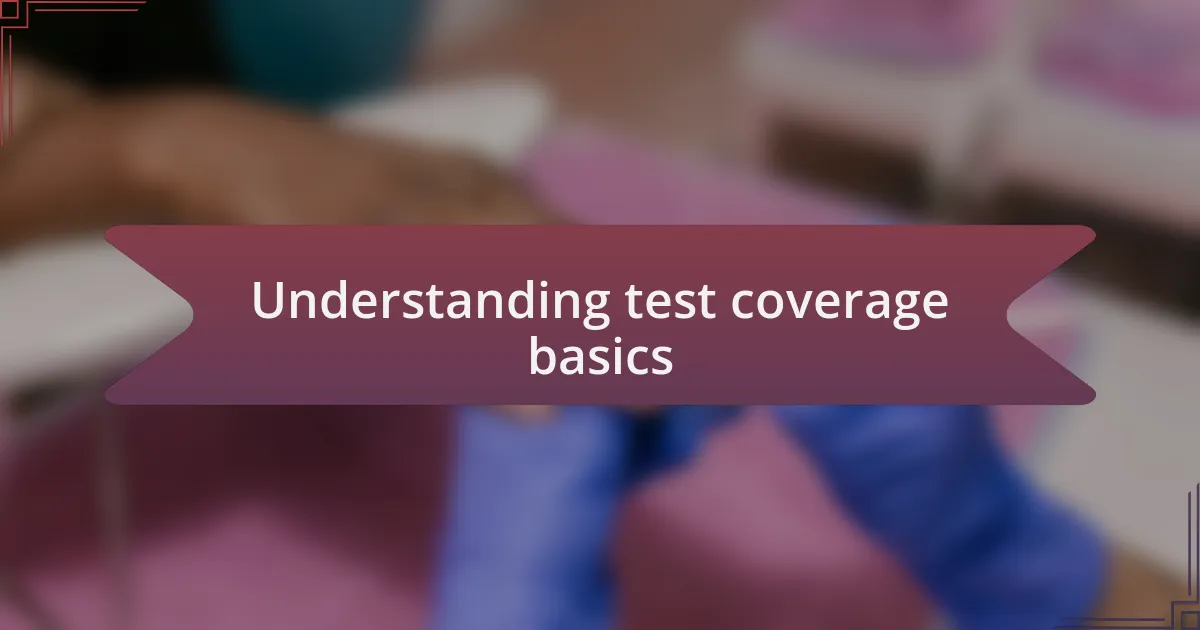
Understanding test coverage basics
Test coverage is a critical metric in software development that measures the extent to which your tests validate the code. I remember the first time I encountered the concept; it was eye-opening to realize that just because my code passed all tests didn’t mean it was thoroughly evaluated. It made me wonder—how can I confidently release software if I don’t understand where my coverage stands?
When diving into test coverage, it’s crucial to recognize the different types: statement coverage, branch coverage, and function coverage, among others. Each type provides unique insights, but I always felt that branch coverage was particularly revealing; it forces you to consider the different paths your code might take. Have you ever cringed at the thought of missing a critical branch? I certainly have, and that’s why I emphasize a comprehensive approach to understanding test coverage.
Additionally, I’ve found that while high test coverage might sound impressive, the quality of tests is equally important. There have been times when I had 80% coverage, but that didn’t guarantee the absence of bugs. It’s a lesson learned—the focus should be on meaningful tests that reflect real-world scenarios, rather than just aiming for a number. What does your test coverage really say about your code? It’s a question worth pondering.
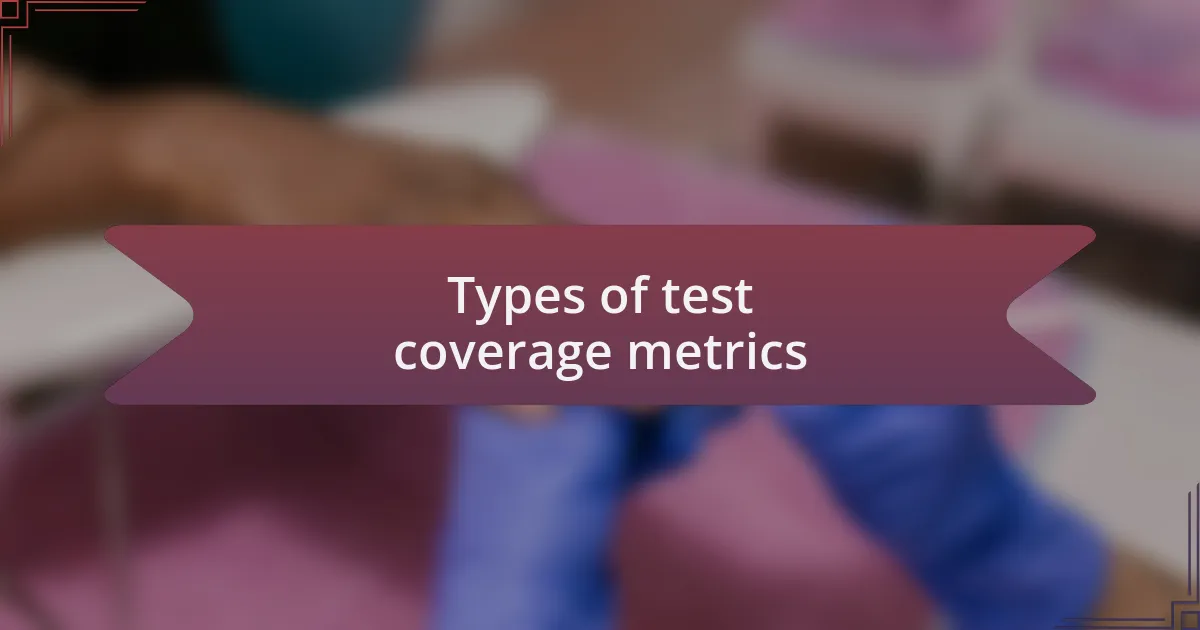
Types of test coverage metrics
When it comes to test coverage metrics, statement coverage is one of the foundational types. It measures whether each line of code has been executed by the tests. I remember the relief I felt when I first achieved full statement coverage—it seemed like a huge milestone. However, that satisfaction faded quickly when I realized that just executing a line of code didn’t account for how effectively that line behaved under different conditions. Have you ever experienced a similar realization?
Branch coverage takes things a step further by ensuring that all possible decision points in your code are tested. This metric always seemed a bit daunting to me, as achieving comprehensive branch coverage means thinking critically about how your code reacts to various inputs. In my experience, I once overlooked a specific input scenario, causing a dreaded bug to surface in production. It was a humbling experience, reinforcing the idea that understanding the branches in your code could mean the difference between success and failure.
Function coverage, on the other hand, gauges whether each function in your codebase has been invoked. I find this metric particularly useful when working on larger projects, where it can be easy to lose track of which functions are actually being tested. Reflecting on my past projects, I often ask myself: are my tests effectively exercising all functions? It’s a reminder that even if your tests run through the code, they need to provide proper validation to ensure robust software performance. By analyzing different types of test coverage metrics, I continue to refine my testing strategies and improve the quality of my software.
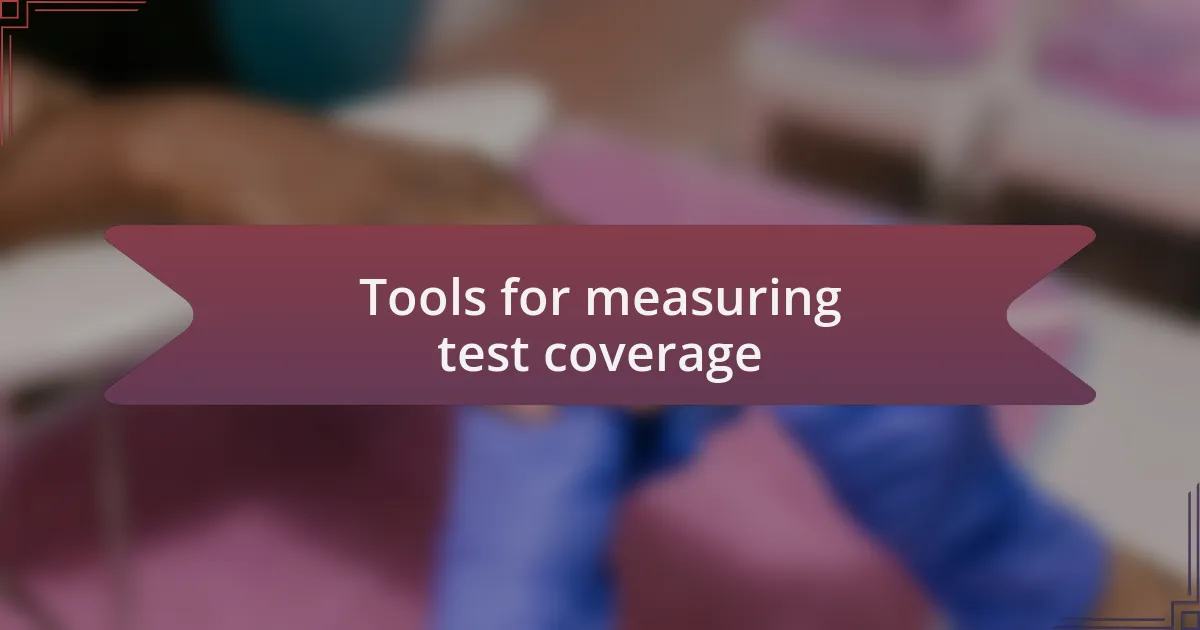
Tools for measuring test coverage
When it comes to selecting tools for measuring test coverage, there are several great options available. For instance, I often use tools like Jacoco for Java projects, which seamlessly integrates with various build systems. I remember the initial confusion I faced while setting it up, but once I got the hang of it, I appreciated how it visually presents coverage data, making it easy to identify untested areas. Isn’t it satisfying to see those coverage numbers tick upward?
Another tool that has proven invaluable for me is Istanbul, particularly for JavaScript applications. It’s incredibly effective at generating coverage reports, which I’ve found essential for communicating test effectiveness to my team. The first time I presented a coverage report that showed significant gaps, I felt both anxious and empowered—it prompted actionable discussions regarding our testing strategy. This experience taught me that tools aren’t just about numbers; they can drive crucial dialogues around quality.
For projects involving Python, I frequently turn to Coverage.py. This tool goes beyond just measuring line coverage; it also offers insights into the parts of the code that are seldom tested. I can vividly recall a project where Coverage.py highlighted a specific module that was barely touched by tests. Addressing that oversight not only improved our coverage but also enhanced the reliability of the entire application. Isn’t it fascinating how the right tool can illuminate blind spots in your testing approach?
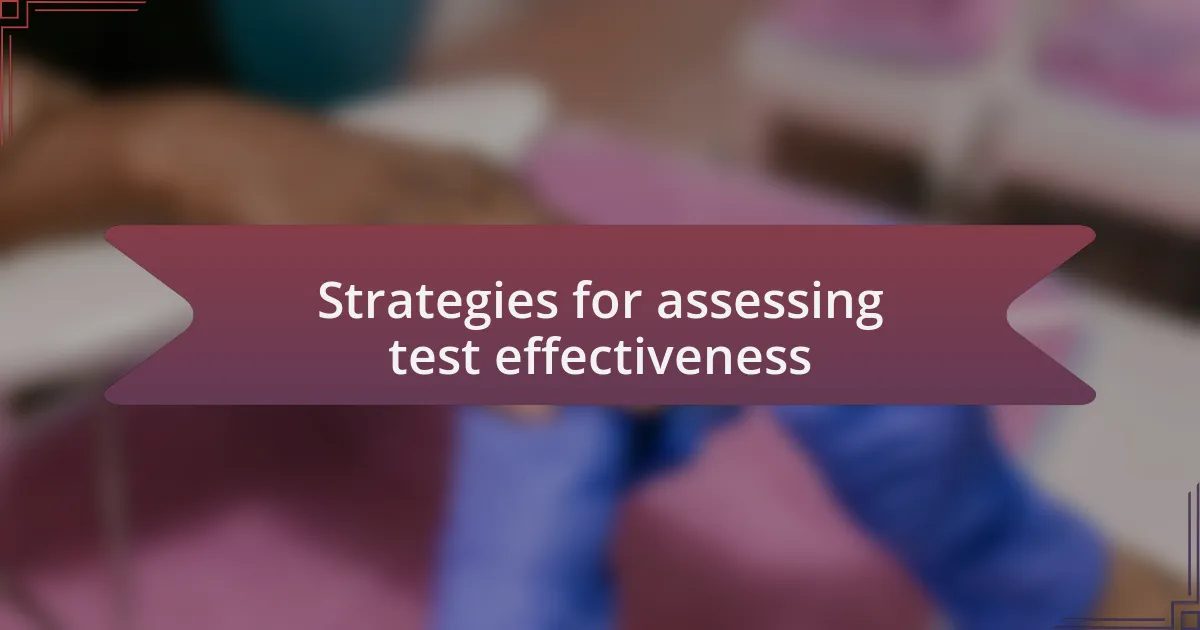
Strategies for assessing test effectiveness
When assessing test effectiveness, one strategy I’ve found particularly useful is peer code reviews. I remember sitting down with a colleague to dissect our test cases together, and it unveiled valuable perspectives on our test coverage. It often surprises me how an outside viewpoint can unearth critical areas that might have otherwise been overlooked. Have you ever had a similar realization during a collaborative review?
Another effective approach is to leverage mutation testing. The first time I implemented this, I was stunned at how it highlighted weaknesses in my tests. It simulates changes to the codebase, helping to identify whether your tests are robust enough to catch those alterations. This eye-opening experience was a game changer for my team’s confidence in our testing strategy—it’s one thing to see coverage numbers and quite another to know those tests are actually making a difference.
Lastly, prioritizing test case reviews based on risk can sharpen your focus. I’ve often created test suites that address the most critical parts of a system first, which not only boosts my confidence in release readiness but also reduces anxiety during production launches. How comforting is it to know you’ve effectively mitigated risk ahead of time? This strategy helps create a proactive mindset towards testing, turning what can feel like a daunting task into a manageable, targeted effort.
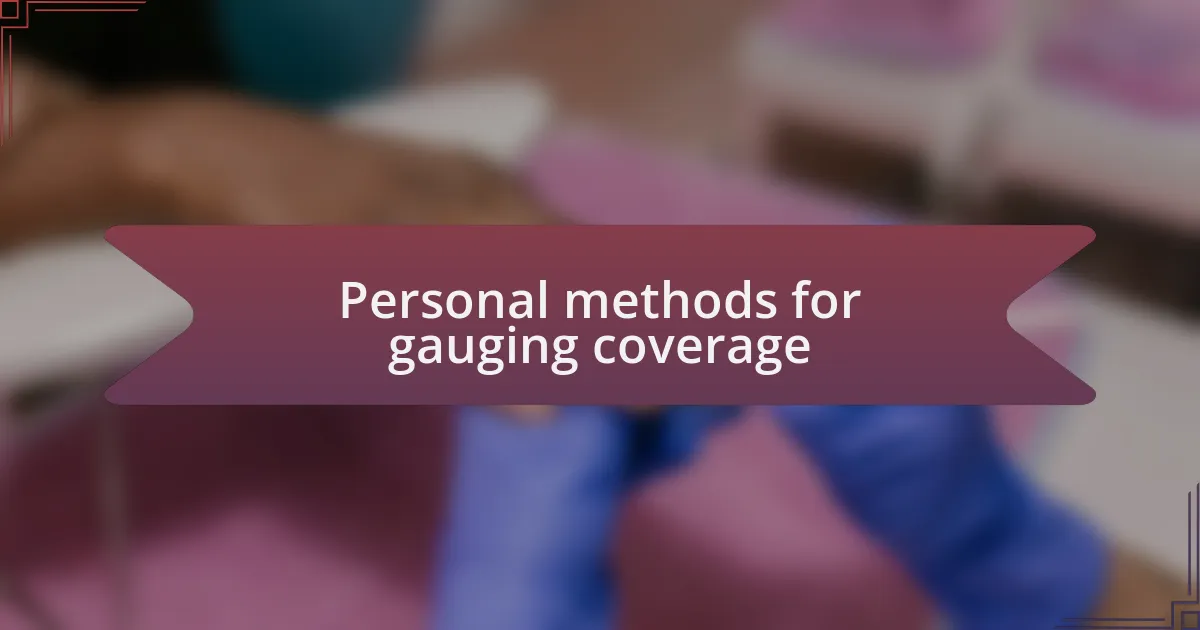
Personal methods for gauging coverage
One personal method I use to gauge coverage effectively is through exploratory testing sessions. I remember the excitement I felt during a late-night coding session when my curiosity pushed me to interact with the application in unexpected ways. This approach allowed me to uncover edge cases that my original test suite had missed—it’s fascinating how stepping outside of structured testing can reveal vulnerabilities. Have you ever tested an application in a way that felt unconventional, yet yielded surprising insights?
Another technique that has served me well is creating a coverage matrix. This tool became a vital part of my workflow when I first attempted to visualize my test coverage across different features. I recall sitting at my desk, color-coding aspects of the matrix to identify gaps. This process not only helped me understand what had been covered but also made it clear where I needed to focus my efforts next. Do you visualize your test coverage, or do you find it easier to keep it all in your head?
Lastly, I frequently embrace user feedback as a gauge for coverage effectiveness. After implementing a new feature, I find reaching out to early users to be incredibly enlightening. Their observations often highlight areas we might have underestimated during development. I distinctly remember a user pointing out a usability flaw that none of my tests had captured—it was a humbling reminder of the importance of real-world perspectives in our testing efforts. How often do you incorporate user feedback into your test coverage assessments?
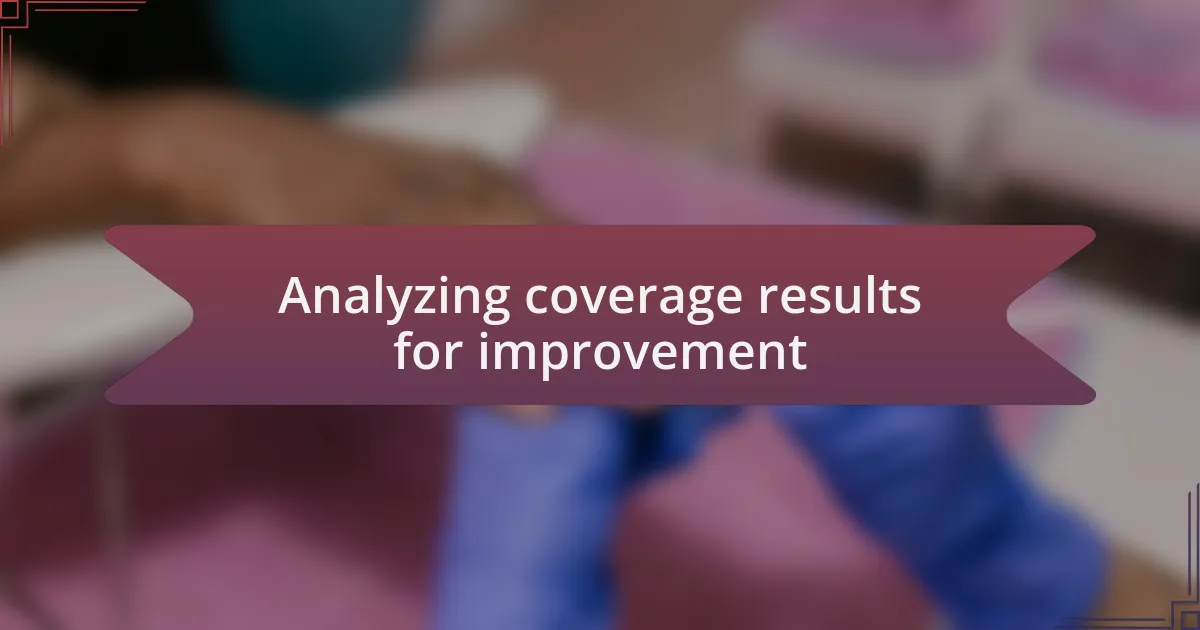
Analyzing coverage results for improvement
When analyzing coverage results, I often dive into specific metrics that tell a deeper story than raw numbers. I vividly recall a time when I noticed a significant drop in coverage percentage after a major code refactor. This prompted me to pull apart the data, revealing that certain areas crucial for user flow were entirely overlooked. Have you ever been jolted by a drop in coverage, only to discover a hidden gap that needed immediate attention?
Another crucial aspect of my analysis involves contextual coverage—understanding not just what is covered, but why it matters. I fondly think back to a project where I paired test coverage with user stories to assess relevance. By aligning my coverage analysis with the user’s journey, I identified tests that were technically sound yet didn’t translate into a good user experience. Have you tried connecting your tests back to user stories to gauge their real impact?
Additionally, I find it immensely helpful to discuss coverage results with my team. I recall a brainstorming session where we gathered around a whiteboard and dissected our coverage reports. It was eye-opening; other team members brought their perspectives, and what I initially deemed acceptable coverage was soon seen as lacking in specific areas. How often do you bring your team together for a collaborative analysis of test coverage?